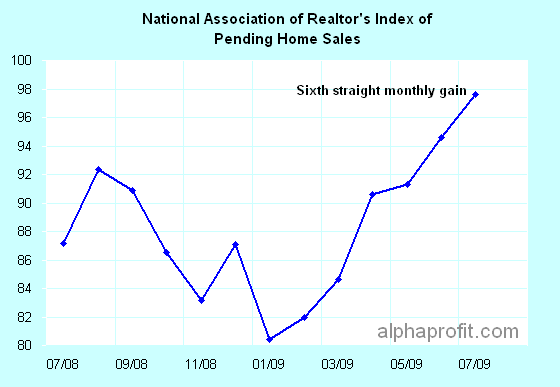The housing market is sending mixed signals. Home sales are rising. Foreclosures are increasing too. Is the worst really over for housing?
Rising Sales of New and Existing Homes
Sales of existing and new homes are increasing. In July, total sales of new and existing homes rose to a 5.673 million annual rate, the highest since November 2007. The steep decline in home prices, low mortgage rates, and an $8,000 tax credit for first-time buyers have helped to prop up demand.
Foreclosures Show No Signs of Abating
Rising unemployment is causing increasing number of homeowners to default on their mortgages. Foreclosures have spiked particularly in states like Nevada, Florida, and California. According to RealtyTrac, 358,471 U. S. properties received a foreclosure notice in August. This represents an 18% increase from August 2008.
Home Prices Tick Up
Even though foreclosures are on the rise, strong increases in sales are helping the housing market to stabilize and enabling home prices to stage a modest rebound.
The S&P/Case Shiller Index which tracks home prices advanced 1.4% in June, its second straight monthly gain.
So, are home prices about to rebound?
Getting a handle on leading indicators for supply of and demand for homes can help in assessing where home prices are likely headed.
Supply of Homes
The news here is mixed.
Rising foreclosures are a concern. They continually bring distressed properties into the market and add to the inventory of unsold homes. Things can get ugly if unemployment rate ticks up to double-digits and causes foreclosure rates to increase further.
Supply from new construction is not nearly a concern as much. The Commerce Department recently stated that housing starts in July tallied 587,000, down 1% from June.
Building permits, an indication of future construction activity, too declined 1.8% to a seasonally adjusted annual rate of 560,000 in July. Number of building permits issued in July 2008 is nearly 40% lower than a year-ago prior to the financial meltdown.
Demand for Homes
It is useful to look at a leading indicator like pending home sales that track contract signings.
The National Association of Realtors recently announced that pending home sales gained 3.2% in July. This follows a 3.6% increase in June. Such strength in contract signings augurs well for home sales going forward.

Buyers are however turning frugal with their home purchases. The Commerce Department’s data show that sales of new homes costing less than $200,000 accounted for nearly half of all sales in the first half of 2009. The average size of new homes is down to 2,065 square feet.
All said, the housing market appears to have stabilized. As long as the job market doesn’t get much worse and mortgage rates don’t rise too much, home sales should continue to trend upward and help home prices to recover further.
The strength of the recovery is likely to be subdued and drawn-out as high levels of foreclosures offset restraint on new construction.
The investment implications of this analysis are discussed in a separate article titled 3 Housing Investments Best Suited for a Recovery.

 Sick buying high & selling low? Fed up of the fees you pay? Tired researching investments? End your financial pain now. You have the opportunity to
Sick buying high & selling low? Fed up of the fees you pay? Tired researching investments? End your financial pain now. You have the opportunity to 


 DEC. 1993 to DEC. 2023
DEC. 1993 to DEC. 2023





